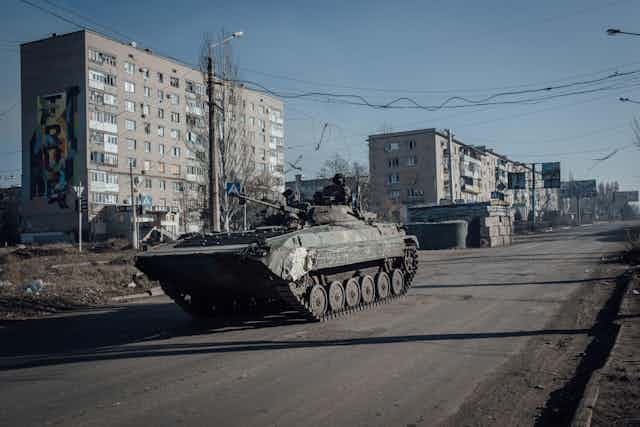Every military conflict contains situations that eventually become its defining symbols.
The second world war, for example, could be summed up in the following seven symbols: the Munich agreement (appeasement), Battle of Britain (resistance), attack on Pearl Harbor (US entry), Auschwitz concentration camp (inhumanity), siege of Stalingrad (turning point), Normandy landings (decisive action), bombings of Hiroshima and Nagasaki (end). Symbols, as the American anthropologist Clifford Geertz once put it, “store” meanings.
The Berlin airlift, initiated in response to the Soviet blockade of western-controlled sectors of the city in June 1948, is among the most potent symbols of the cold war.
The city and Germany had been run by four occupying powers as part of the post-second world war settlement: the United States, the Soviet Union, the United Kingdom and France. The Soviets tried to push the western powers out of the city by cutting off all land and water routes in to Berlin on June 24. They stopped all goods, fuel and food. The western airlift of essential items was something that the Soviets clearly did not expect. After 11 months they lifted the blockade, in May 1949.
The 75th anniversary of the start of the airlift on June 26 offers an opportunity to reflect not only on how the west (led by the United States) successfully faced down an aggressive adversary, but also on the importance of symbols.
Read more: Berlin airlift and Ukraine war: the importance of symbols during conflicts
Symbols shape conflicts. Conflicts revolve around symbols and this one was no exception. In the process of the Berlin airlift, a symbol was created. The Soviets backed down, and the allies showed they were prepared not to give up on Berlin.
Symbolic moments
From Geertz’s observation about symbols – they store meanings – two crucial questions arise. First, what meaning does this symbol store? Second, what is the role of symbols in conflicts more generally?
Both questions are particularly significant given the current war in Ukraine where the west, after some initial wavering, has decided to face another act of Russian aggression. In March 2022, MP Tobias Ellwood, chair of the UK House of Commons defence select committee, was quick to make the link between 1948-9 and the war in Ukraine:
The scale of international assistance that’s now required across Ukraine is greater than the 1948 Berlin airlift operation .
Symbols have come to define the war in Ukraine too – think about Russian assaults on Bucha, Mariupol or Bakhmut.
In the coming days much will be said about the Berlin airlift as a symbol of resolve and resistance. And that is undoubtedly true. West Berlin’s main value was not military or strategic, but symbolic. US president Harry Truman repeatedly made it clear that the US and its allies were not leaving Berlin. However, there is also a practical lesson stored in this symbol which carries immediate relevance in today’s world. Any talk about resolve must be backed up and accompanied by capability to carry out the necessary actions.
In the case of Berlin, no amount of resolve would have been enough had the allies not had the ability to sustain the airlift for nearly a year. At its peak, an aircraft was landing in Berlin almost every minute.
Understanding significant moments
The role of symbols in politics, and especially in warfare, is often remarked upon, but rarely studied in depth. The work of our late colleague, professor of international politics Andrew Linklater, examines how across the course of human history symbols have affected the use of violence.
Linklater shows that symbols have shaped considerations about acceptable and unacceptable forms of violence, but he has less to say about the significance of symbols in the pursuit of wars.
The key to understanding symbols in warfare is whether symbolic victories affect outcomes of strategic conflicts. A good example is provided by the fight over the eastern Ukrainian city of Bakhmut during the past year, where thousands have died as Russian and Ukrainian troops battled for control.
Commentators have increasingly emphasised its symbolic rather than strategic value. Russia has not been able to derive much – neither symbolically, nor strategically – once it finally came to control the town which it reduced to rubble. While Russia has not been able to make Bakhmut a symbol, Ukraine has used it to demonstrate its determination to stand up to the invading force.
Symbolic victories matter in strategic conflicts only when they can be endowed with meaning. The symbolic value of West Berlin was precisely in the act of defending what on the surface appeared to be indefensible – a tiny bit of western territory deep in the Soviet-controlled part of Germany.
As many, including the US secretary of defence Lloyd Austin, have noted, Bakhmut has become a similar symbol – a strategically relatively insignificant town turned into a symbol of Ukraine’s resolve and resistance. When Russia claimed to have taken the city, Ukraine insisted it would continue to fight on. It’s become a symbol of plucky Ukrainians who, like Berliners and their western allies in 1948, are determined not to give up.
While the current war in Ukraine plays out on a vastly different scale, the underlying logic of this conflict means that the lessons from the Berlin airlift remain relevant. Without the continued western willingness to commit serious and sustained material resources – Ukraine will become a symbol of western timidity.
Ukraine should not be put under unnecessary pressure by assertions that material and military support will eventually have to end because it will become unsustainable. In June 1948, neither side thought the airlift would last as long as it did, but the allies committed to it, compelling the Soviets to back down.
Finally, when a particular fight becomes symbolic, there needs to be a clear idea what meaning it has. It is such meaning that gives symbols their strategic power.

